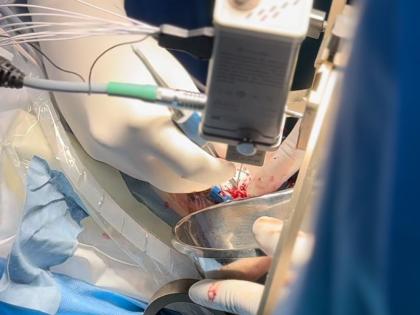NIMHANS Deep Brain Stimulation, a Promising Treatment for Severe OCD Patients
By Anubha Jain | Published: March 11, 2024 07:15 PM2024-03-11T19:15:57+5:302024-03-11T19:16:58+5:30
Obsessive-compulsive disorder (OCD) can sometimes be difficult to treat with medication and psychotherapy. For these patients, Deep Brain Stimulation ...

NIMHANS Deep Brain Stimulation, a Promising Treatment for Severe OCD Patients
Obsessive-compulsive disorder (OCD) can sometimes be difficult to treat with medication and psychotherapy. For these patients, Deep Brain Stimulation (DBS), a highly complex, advanced, and precise neurosurgical treatment that uses electrical impulses has shown promising outcomes in regulating extreme cases of psychiatric conditions like obsessive-compulsive disorder (OCD).
DBS is a very effective treatment for OCD patients with severe problems and this procedure can improve their lives significantly. The researchers, doctors, and scientists of the National Institute of Mental Health and Neuro Sciences NIMHANS studied in detail the treatment which involves stimulating particular parts of the brain using fine electrodes. This study is the first of its kind from India.
Dr. Dwarkanath Srinivas, Dept. of Neurosurgery NIMHANS, who undertook surgeries in an exclusive interview with Lokmat Times representative Anubha Jain, said, “Since 2007 we have been using deep brain stimulation to treat Parkinson's disease. But after COVID we are using this study for OCD patients.” He said that the treatment is recommended for severe patients who don’t improve with non-invasive treatments like medicines and Cognitive Behavioural Therapy (CBT). The effects are long-term and it's a safe treatment.
Through brain scans, doctors locate the part of the brain that is causing symptoms. Dr. Srinivas while discussing the procedure said, “We implant thin electrodes in the specific areas of the brain along with a neurostimulator and connect these with an external device similar to a pacemaker through connecting wires, that deliver mild electrical signals. Then the electrodes get connected, which carry the electrical current to the neurostimulator. This system helps to send electrical signals to the brain, which helps with OCD symptoms.”
He further said “All patients are from NIMHANS but for planning the protocol and how to go about this study, for that, we have taken the help of a French university. The patients get proper approval from a designated and authorized committee then any surgery can be planned for them.” Talking about the surgeries conducted so far, he said, “We have done nine patient surgeries. Out of which in an interim analysis of six months on seven patients, who underwent surgery, as many as five patients showed complete response on the scoring and two showed partial response. Later it was compared with six patients who did not undergo surgery among whom only one was a partial respondent.” Dr. Srinivas said that a complete response means the disease is significantly reduced. After the surgery sometimes a patient needs medication support also. However, the amount of time for example a person with a cleaning obsession spends in the bathroom cleaning himself/herself for 10-15 hrs. after the stimulation or procedure comes down significantly to 2 to 3 hrs. per day, he added.
It is important to mention that with an approximate global prevalence of 2% per population, the symptoms of OCD generally include repetitive, unwanted thoughts causing anxiety, forcing the individual to perform compulsive tasks to decrease anxiety. The most common presentations include fears of getting contaminated associated with washing, repeated doubts and checking, arranging or counting, and having repugnant thoughts, which may at times be sexual or aggressive. OCD has a lifetime prevalence of 2%-3%. It begins in childhood, puberty, or early adult life, and thus affects a critical period in relational and academic development.
Dr. Shyam Sundar, Department of Psychiatry who heads the OCD Clinic at NIMHANS said, "The positive outcome of the DBS technique is that the alterations it can cause in the brain are reversible and can be regulated post-surgery. When any patient shows mild side effects like hands or legs shakiness, the stimulation gets adjusted through external regulation."
Open in app